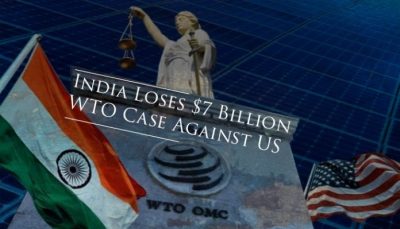India Loses $7 Billion WTO Case Against the US

India has lost a $7 billion WTO case against US. Meanwhile China has won its case with the WTO now allowing the Chinese to impose a $3.6 billion sanction on American goods. The verdict comes days after India and US officially suspended defense cooperation in what is now giving rise to a full-fledged India-US Trade War. India, meanwhile, is engaged in negotiations with China and Southeast Asian nations over a new RCEP Agreement seen by observers as a threat to India’s Seed Sovereignty.
The U.S. won a case against India at the World Trade Organization alleging improper use of export subsidies valued at more than $7 billion, reported Bloomberg.
The WTO’s dispute-resolution panel agreed that “India gives prohibited subsidies to producers of steel products, pharmaceuticals, chemicals, information technology products, textiles, and apparel, to the detriment of American workers and manufacturers,” the U.S. Trade Representative in Washington said in a statement Thursday.
WTO rules prohibit export subsidies, but makes exceptions for developing countries until they reach certain economic benchmarks. India’s exemption expired, according to USTR, and the Geneva-based trade body rejected the country’s position that it was entitled to more time even after hitting the threshold.
The case was filed in March 2018 by the U.S., challenging what it said were illegal export subsidies provided to Indian firms. The decision, which can be appealed, comes amid a brewing India US Trade War.
According to leaked information of a high-level meeting, the United States and India’s failure to reach a long-expected trade deal on Sept. 24 has sparked fears of a full-fledged India US #TradeWar.https://t.co/CusYEQWAdB
— GreatGameIndia (@GreatGameIndia) October 1, 2019
The Trump administration earlier this year canceled India’s preferential access to the U.S. market under a scheme for developing countries and since then the two sides have been engaged in stop-start negotiations to resolve their differences.
On Sept. 24, U.S. Trade Representative Robert Lighthizer and Indian Commerce Minister Piyush Goyal met on the sidelines of the U.N. General Assembly, raising expectations that the two sides were poised to reveal a new trade deal following months of talks.
But according to information leaked from the meeting as reported by Stratfor, the negotiators failed to agree on Indian concessions on information and communication technology, dairy, pharmaceuticals, agriculture, e-commerce, and data localization — in short, every bone of contention that have stymied an agreement for months. Still, U.S. President Donald Trump told visiting Indian Prime Minister Narendra Modi the same day that they would be able to announce a trade deal soon.
Bilateral trade, which totaled $142.1 billion last year, remains the major friction point in the U.S.-India relationship. India exported $83.2 billion worth of goods and services to the United States and imported $58.9 billion, resulting in a $24.3 billion surplus. Trump, pointing to the imbalance, has singled Modi out in the past as the “tariff king,” demanding that New Delhi reduce its trade surplus with Washington and lower tariff barriers for American commerce in India.
After #TradeWar now #India suspends #Defense Cooperation after Americans refuse to give India high-end Jet Engine technology.
Is the Indo-US Strategic Partnership officially dead?https://t.co/AMmn0myshD
— GreatGameIndia (@GreatGameIndia) October 25, 2019
The US imposed on India an additional tariff of 25% and 10% on import of steel and aluminum products in March last year. In April, a Congressional Research Service brief on US-India trade relations noted, “Bilateral tensions have increased over each side’s tariff policies.” Then, on May 31 – the day after the inauguration of NDA government to start its second term – the Trump administration announced that it was terminating India’s participation in the Generalized System of Preferences (GSP) which allows eligible developing countries to import to the United States duty free. Last year, the GSP accounted for approximately $5 billion of the $83.2 billion in imports India sent to the US.
In response, the government of India imposed retaliatory tariffs on 28 products originating or exported from the US with effect from 16th June this year. India is expected to get an additional $217 million of revenue from the retaliatory tariffs. This tit-for-tat created substantial tension in the India-US relationship going into the G20 Summit.
Most recently, in a major development brewing for sometime now, India and US have officially suspended Defense Cooperation after Americans refused to give India high-end jet-engine technology. At the heart of the Indo-US Strategic Partnership is what is known as the Defense Technology and Trade Initiative or DTTI. Under the 2012 DTTI, India and the US set up joint working groups (JWGs) for cooperation on aircraft carriers and jet engine technology, all of the 4 pathfinder projects have now been shutdown. The move comes days after former US Secretary of State and National Security Adviser Henry Kissinger’s visit to India.
RCEP agreement if implemented will bypass #WTO & offload excess #agricultural produce from #China into #Indian markets freely. Shifting our balance of payment & #foodsecurity into Chinese hands will be detrimental to our #SeedSovereignty says @IndraSsingh. https://t.co/evCTeWGZR9
— GreatGameIndia (@GreatGameIndia) November 1, 2019
India, meanwhile, is engaged in negotiations with China and Southeast Asian nations over a new Regional Comprehensive Economic Partnership. RCEP Agreement seen by observers as a threat to India’s Seed Sovereignty would create a vast free-trade bloc spanning the Indo-Pacific from New Zealand in the east to India in the west and China and Japan to the north. The RCEP agreement, if implemented, will offload all the excess agricultural produce from China into the Indian markets freely shifting our balance of payment and food sovereignty into Chinese hands.
*
Note to readers: please click the share buttons above or below. Forward this article to your email lists. Crosspost on your blog site, internet forums. etc.
Featured image is from GGI

